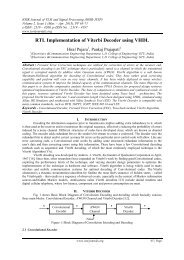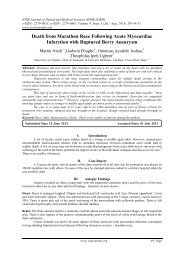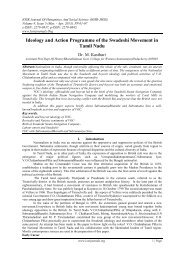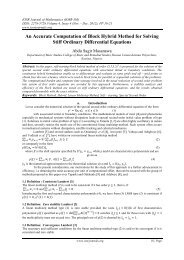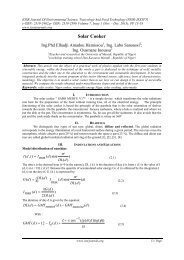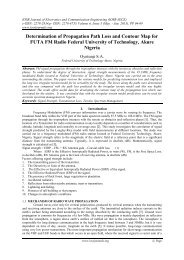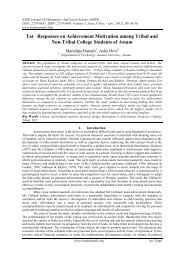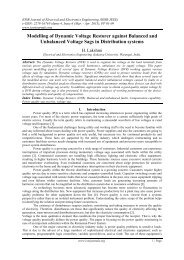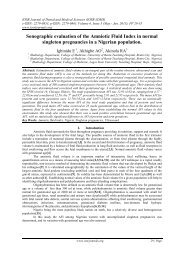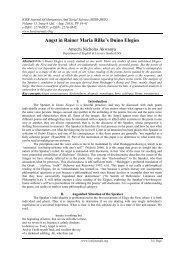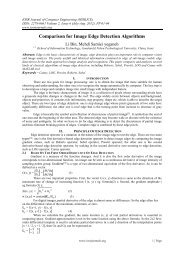Design Compatibility of Classroom Furniture in Urban and ... - IOSR
Design Compatibility of Classroom Furniture in Urban and ... - IOSR
Design Compatibility of Classroom Furniture in Urban and ... - IOSR
Create successful ePaper yourself
Turn your PDF publications into a flip-book with our unique Google optimized e-Paper software.
Fuel Subsidy Removal And M<strong>in</strong>d Control Game In Nigeria: A Critical Discourse Analysis Perspective<br />
In the next section, we subject the fester<strong>in</strong>g ‗tug <strong>of</strong> war‘ between the Federal Government <strong>of</strong> Nigeria <strong>and</strong><br />
the Nigerian masses on the fuel subsidy removal to analysis <strong>and</strong> determ<strong>in</strong>e the extent to which the m<strong>in</strong>d control<br />
game is exploited by the more powerful group to reproduce dom<strong>in</strong>ance <strong>and</strong> social <strong>in</strong>equality <strong>in</strong> Nigeria.<br />
III. Discussions<br />
3.1 Federal Government’s coercive persuasion as m<strong>in</strong>d-control strategy<br />
‗M<strong>in</strong>d control‘ (also referred to as 'bra<strong>in</strong>wash<strong>in</strong>g,' 'coercive persuasion,' 'thought reform,' <strong>and</strong> the<br />
'systematic manipulation <strong>of</strong> psychological <strong>and</strong> social <strong>in</strong>fluence') refers to a process <strong>in</strong> which a group or<br />
<strong>in</strong>dividual systematically uses unethically manipulative methods to persuade others to conform to the wishes <strong>of</strong><br />
the manipulator(s), <strong>of</strong>ten to the detriment <strong>of</strong> the person be<strong>in</strong>g manipulated," (Langone <strong>in</strong> Ofshe, 2003). Cit<strong>in</strong>g<br />
Sche<strong>in</strong> (1961) <strong>and</strong> Lifton (1961), Ofshe (2003) observes that ―ccoercive persuasion <strong>and</strong> thought reform are<br />
alternate names for programmes <strong>of</strong> social <strong>in</strong>fluence capable <strong>of</strong> produc<strong>in</strong>g substantial behavior <strong>and</strong> attitude<br />
change through the use <strong>of</strong> coercive tactics, persuasion, <strong>and</strong>/or <strong>in</strong>terpersonal <strong>and</strong> group-based <strong>in</strong>fluence<br />
manipulations.‖ In his op<strong>in</strong>ion, Zimbardo (1971) <strong>in</strong> Ofshe (2003) sees m<strong>in</strong>d control as the process by which<br />
<strong>in</strong>dividual or collective freedom <strong>of</strong> choice <strong>and</strong> action is compromised by agents or agencies that modify or<br />
distort perception, motivation, affect, cognition <strong>and</strong>/or behavioral outcomes.<br />
A comb<strong>in</strong>ation <strong>of</strong> staple social <strong>in</strong>fluence <strong>in</strong>gredients - conformity, compliance, persuasion, dissonance,<br />
reactance, guilt, fear arousal, model<strong>in</strong>g, identification - tends to create a powerful crucible <strong>of</strong> extreme mental<br />
<strong>and</strong> behavioural manipulation when synthesized with several other real-world factors, such as charismatic,<br />
authoritarian leaders, dom<strong>in</strong>ant ideologies, social isolation, physical debilitation, <strong>in</strong>duced phobias, <strong>and</strong> extreme<br />
threats or promised rewards that are typically deceptively orchestrated, over an extended time period <strong>in</strong> sett<strong>in</strong>gs<br />
where they are applied <strong>in</strong>tensively.<br />
In her technical overview <strong>of</strong> m<strong>in</strong>d control tactics, S<strong>in</strong>ger <strong>in</strong> Ofshe (2003) notes that a coercive<br />
persuasion programme is a behavioural change technology applied to cause the "learn<strong>in</strong>g" <strong>and</strong> "adoption" <strong>of</strong> a<br />
set <strong>of</strong> behaviors or an ideology under certa<strong>in</strong> conditions. It is dist<strong>in</strong>guished from other forms <strong>of</strong> benign social<br />
learn<strong>in</strong>g or peaceful persuasion by the conditions under which it is conducted <strong>and</strong> by the techniques <strong>of</strong><br />
environmental <strong>and</strong> <strong>in</strong>terpersonal manipulation employed to suppress particular behaviors <strong>and</strong> to tra<strong>in</strong> others.<br />
With coercive persuasion, one can change people's attitudes without their knowledge <strong>and</strong> volition. One can<br />
create new "attitudes" where they will do th<strong>in</strong>gs will<strong>in</strong>gly which they formerly may have detested, th<strong>in</strong>gs which<br />
previously only torture, physical pa<strong>in</strong>, or drugs could have coerced them to do.<br />
Coercive persuasion or thought reform is best understood as a coord<strong>in</strong>ated system <strong>of</strong> graduated<br />
coercive <strong>in</strong>fluence <strong>and</strong> behavior control designed to deceptively <strong>and</strong> surreptitiously manipulate <strong>and</strong> <strong>in</strong>fluence<br />
<strong>in</strong>dividuals, usually <strong>in</strong> a group sett<strong>in</strong>g, <strong>in</strong> order for the orig<strong>in</strong>ators <strong>of</strong> the programme to pr<strong>of</strong>it <strong>in</strong> some way,<br />
normally f<strong>in</strong>ancially or politically. Hunter (1951) <strong>in</strong> Ofshe (2003) referred to such programmes as<br />
―bra<strong>in</strong>wash<strong>in</strong>g‖. S<strong>in</strong>ger identified about seven ma<strong>in</strong> tactic types found <strong>in</strong> various comb<strong>in</strong>ations <strong>in</strong> a typical<br />
coercive persuasion programme. Also, Robert Jay Lifton <strong>in</strong> Ofshe (2003) articulated an 8-po<strong>in</strong>t model <strong>of</strong><br />
thought reform. We sift through these models <strong>and</strong> determ<strong>in</strong>e the extent to which they fit <strong>in</strong>to the m<strong>in</strong>d control<br />
stratagem <strong>of</strong> government on the issue <strong>of</strong> fuel subsidy removal.<br />
3.1.1. Thought reform through <strong>in</strong>creased suggestibility <strong>and</strong>/or "s<strong>of</strong>ten<strong>in</strong>g up” <strong>and</strong> dem<strong>and</strong> for purity.<br />
In this regard, the less powerful group is prepared for thought reform <strong>and</strong> made receptive to dem<strong>and</strong> for<br />
purity by the more powerful group. The explicit goal <strong>of</strong> the dom<strong>in</strong>ant group is to br<strong>in</strong>g about some k<strong>in</strong>d <strong>of</strong><br />
change, whether it is on a global, social, or personal level. Solution to an exist<strong>in</strong>g problem is only possible if one<br />
stays with the group <strong>and</strong> is committed. The m<strong>in</strong>dset <strong>of</strong> the Federal Government on the fuel subsidy removal<br />
seems to be driven by the aforementioned thought reform stratagems as can be gleaned from Texts 1 – 19 (See<br />
Appendix). President Jonathan set <strong>in</strong> motion the thought reform <strong>and</strong> dem<strong>and</strong> for purity when he sent the 2012-<br />
2015 Medium Term Fiscal Frameworks (MTFF) <strong>and</strong> the Fiscal Strategy Paper (FSP) memo to the National<br />
Assembly on 4 October, 2011. As the President noted, ―A major component <strong>of</strong> the policy fiscal consolidation is<br />
government‘s <strong>in</strong>tent to phase out fuel subsidy, beg<strong>in</strong>n<strong>in</strong>g from the 2012 fiscal year.‖ Discont<strong>in</strong>u<strong>in</strong>g with the<br />
subsidy rema<strong>in</strong>ed the only responsible way <strong>of</strong> harness<strong>in</strong>g revenue for capital stock formation, among others.<br />
His words: ―There are proposals to phase out petroleum subsidies <strong>in</strong> a deliberate <strong>and</strong> responsible way that will<br />
harness revenues for capital stock formation <strong>and</strong> leverage on private sector <strong>in</strong>vestments <strong>in</strong> public-private<br />
partnerships (PPPs).‖<br />
Government defended its decision to deregulate the <strong>in</strong>dustry based on the its conviction that ―the huge<br />
subsidy be<strong>in</strong>g paid on petroleum products has constra<strong>in</strong>ed government spend<strong>in</strong>g on the development <strong>of</strong> adequate<br />
<strong>in</strong>frastructural facilities <strong>and</strong> depletion <strong>of</strong> national revenue pr<strong>of</strong>ile; that it encourages <strong>in</strong>efficient utilization <strong>of</strong><br />
resources <strong>and</strong> product smuggl<strong>in</strong>g across the borders; that the consumers <strong>of</strong> kerosene for <strong>in</strong>stance do not buy the<br />
product at a regulated/subsidized price set by the government due to distribution bottlenecks, multiple h<strong>and</strong>l<strong>in</strong>g<br />
www.iosrjournals.org<br />
8 | Page



